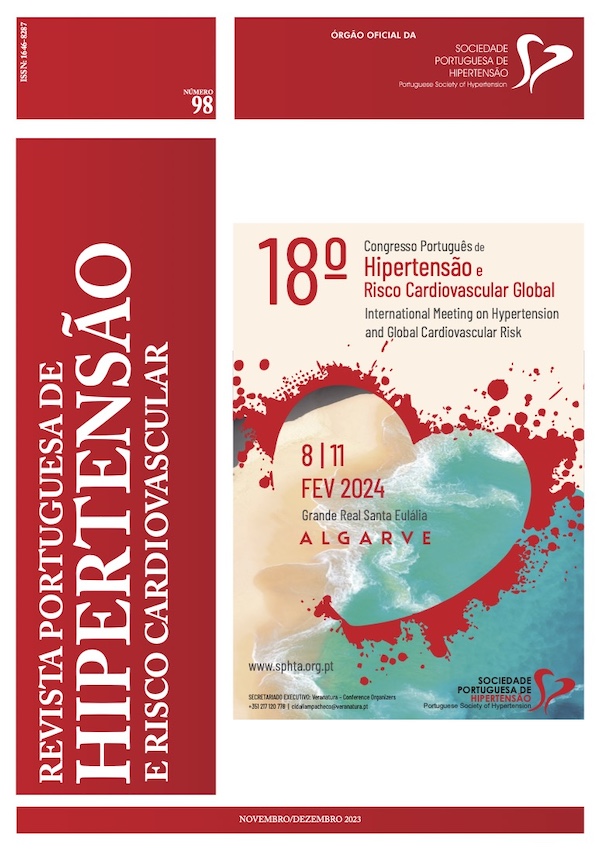THE INFLUENCE OF ARTERIAL HYPERTENSION ON ISCHEMIC STROKE: CLOSE RELATIONSHIP THAT MUST BE STOPPED
DOI:
https://doi.org/10.58043/rphrc.110Keywords:
Hypertension, Ischemic Stroke, Cardiovascular Risk FactorsAbstract
Introduction: The Cerebral Vascular Accident (CVA) is an important cause of death in Europe and the primary cause of death in Portugal, most of which is ischemic in origin (69-75%). Arterial hypertension (HTN) is the most important risk factor for cardiovascular morbidity and death, being a major risk factor for ischemic stroke. The present study aims to assess the prevalence of hypertension as a risk factor in patients who had ischemic stroke, taking into account the frequency of blood pressure (BP) on admission, the most used classes of antihypertensives and therapeutic changes at the time of discharge.Materials and Methodoly: Retrospective observational study in which stroke patients were admitted to the U-AVC of a region hospital, between January 1, 2019 and November 15, 2019. The authors collected data taking into account GDH coding and examination of clinical processes.
Results and Discussion: From the 199 patients admitted to the Stroke Unit, 173 patients were included with a diagnosis of ischemic stroke. As of the 173 patients included in the study, 43.9% were female and 56.1% male, of which 73% had a diagnosis of HTA. These, 66% were given medication and 7% had a diagnosis but were not given medication. At the arrival to the emergency service, only 22% of patients with a previous diagnosis of AHT and that have been medicated were normotensive. 60% of patients received monotherapy. From the medication used, most fitted to the 1st line, with Agiotensin Converting Enzyme Inhibitors (ACEIs) being the most used (33%). At the end of the treatment, 31.2% maintained therapy, 26% changed therapy and 15% started therapy again.
Conclusion: Adequate hypertension control in ischemic stroke is of highest importance, as a variable risk factor in both primary and secondary prevention. Therefore, effective blood pressure control is an important resource against stroke.
Downloads
References
Biller J, Love BB, Schneck MJ. Vascular Diseases of the Nervous System: ischemic cerebrovascular disease. En: Bradley WG, Daroff RB, Fenichel G, Jankovic J, editores. Neurology in Clinical Practice Principles of Diagnosis and Management. 5th ed. Philadephia: Elsevier Inc; 2008. p. 1165–216.
Furie K, Kasner S, Adams R, Albers G, Bush R, Fagan S, et al. Guidelines for the Prevention of Stroke in Patients With Stroke or Transient Ischemic Attack: A Guideline for Healthcare Professionals From the American Heart Association/American Stroke Association. Stroke. 2011;42:227–76.
Fox CS, Evans JC, Larson MG, et al. Temporal trends in coronary heart disease mortality and sudden cardiac death from 1950 to 1999: the Framingham Heart Study. Circulation, 2004;110:522-527.
Grysiewicz RA, Thomas K, Pandey DK. Epidemiology of ischemic and hemorrhagic stroke: incidence, prevalence, mortality, and risk factors. Neurol Clin 2008; 26:871.
Harmsen P,Lappas G,Rosengren A,Wilhelmsen L. Long-term risk factors for stroke: twenty-eight years of follow-up of 7457 middle-aged men in Göteborg, Sweden. Stroke 2006; 37:1663.
O’Donnell MJ, Chin SL, Rangarajan S, et al. Global and regional effects of potentially modifiable risk factors associated with acute stroke in 32 countries (INTERSTROKE): a case-control study. Lancet 2016; 388:761.
Chalmers J, Beilin L, Mancia G, Whitworth J, Zanchetti A. International Society of Hypertension (ISH): statements on blood pressure and stroke. J Hypertens.2003; 21:651.
Graeme J. Hankey Lowering blood pressure. En: Stroke Treatment and Prevention An Evidence-Based Approach. Cambridge: Cambridge University Press; 2005. p. 288–95.
Blood Pressure Lowering Treatment Trialists’ Collaboration. Effect of different blood-pressure lowering regimens on major cardiovascular events: results of prospectively designed overviews of randomised trials. Lancet. 2003;362:1527–35.
Kannel WB. Risk stratification in hypertension: new insights from Farmingham Study. Am J Hypertens, 2000;13:3S-10S
Lewington S, Clarke R, Qizilbash N, et al. Age-specific relevance of usual blood pressure to vascular mortality: a meta-analysis of individual data for one million adults in 61 prospective studies. Lancet 2002; 360:1903.
Caplan LR. Basic pathology, anatomy, and pathophysiology of stroke. In: Caplan’s Stroke: A Clinical Approach, 4th ed, Saunders Elsevier, Philadelphia 2009. p.22.
AppelrosP,StegmayrB,TerentA.Sexdifferences in stroke epidemiology: a systematic review. Stroke.2009; 40(4):1082-90.
Gargano JW, Reeves MJ. Sex differences in stroke recovery and stroke-specific quality of life: results from a statewide stroke registry. Stroke. 2007;38(9):2541-8.
Reeves MJ, Bushnell CD, Howard G, Gargano JW, Duncan PW, Lynch G, et al. Sex differences in stroke: epidemiology, clinical presentation, medical care, and outcomes. Lancet Neurol. 2008;7(10):915-26.
Kernan WN, Ovbiagele B, Black HR, et al. Guidelines for the prevention of stroke in patients with stroke and transient ischemic attack: a guideline for healthcare professionals from the American Heart Association/American Stroke Association. Stroke 2014; 45:2160.
Rothwell PM, Howard SC, Dolan E, et al. Prognostic significance of visit-to-visit variability, maximum systolic blood pressure, and episodic hypertension. Lancet 2010; 375:895.
Touzé, E.; Coste, J.; Voicu, M. et al. “ mportance of in-hospital iniciation of the therapies and therapeutic inertia in secundary stroke prevntion. IMPACT study”. Stroke, 2008,39; 1834-1343
Whelton PK, Carey RM, Aronow WS, et al. 2017 ACC/AHA/AAPA/ABC/ACPM/AGS/ APhA/ASH/ASPC/NMA/PCNA Guideline for the Prevention, Detection, Evaluation, and Management of High Blood Pressure in Adults: A Report of the American College of Cardiology/ American Heart Association Task Force on Clinical Practice Guidelines. Hypertension 2018; 71:e13.
Wang WT, You LK, Chiang CE, et al. Comparative Effectiveness of Blood Pressure-lowering Drugs in Patients who have Already Suffered From Stroke: Traditional and Bayesian Network Meta-analysis of Randomized Trials. Medicine (Baltimore) 2016; 95:e3302.
Liu L, Wang Z, Gong L, et al. Blood pressure reduction for the secondary prevention of stroke: a Chinese trial and a systematic review of the literature. Hypertens Res 2019; 32:1032.
Arima H, Chalmers J, Woodward M, et al. Lower target blood pressures are safe and effective for the prevention of recurrent stroke: the PROGRESS trial. J Hypertens 2006; 24:1201.
Powers WJ, Rabinstein AA, Ackerson T, et al. 2018 Guidelines for the Early Management of Patients With Acute Ischemic Stroke: A Guideline for Healthcare Professionals From the American Heart Association/American Stroke Association. Stroke 2018; 49:e46.
Downloads
Published
How to Cite
Issue
Section
License
Copyright (c) 2023 Bárbara Saraiva

This work is licensed under a Creative Commons Attribution 4.0 International License.




